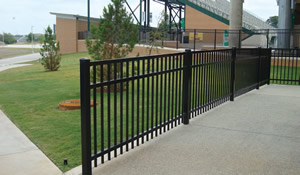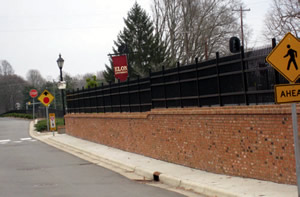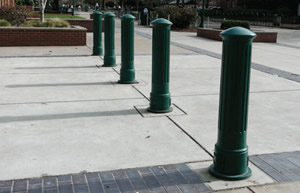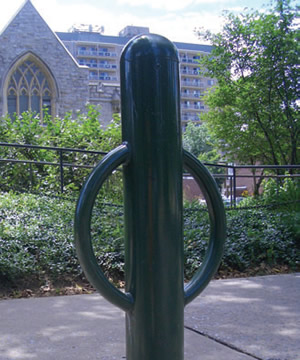Good Fences Make Good Neighbors

PHOTOS COURTESY OF AMERISTAR FENCE PRODUCTS
Fences may make good neighbors, but what makes good fences? Colleges and universities erect fencing and related outside structures to provide security, enhance safety, define space, direct traffic and reflect campus image.
The costs, materials, makes and manufactures vary widely, as do the precise configurations, environments and needs of a given campus. There’s a lot to consider, and some experts recently shared insights about fencing and related systems with College Planning & Management.
Set a Standard
First, setting an explicit standard or set of standards for fencing at various points on a campus makes sense, particularly if the standards are implemented with the guidance of one or two point people on that campus, says Mark Hough, Duke University’s landscape architect. That is, there should be a standard defining what kind of fencing system will be used for what areas of campus, as in visible areas will have a different go-to type of fence than will hidden areas, for example. But there is also the need to define fencing systems informed by the kinds of security and safety scenarios on a campus.
Hough has worked on various fencing projects on his Durham, NC campus, including a telling one: a recent master plan for fencing on the university’s central campus. The plan, which is projected to cost about $100,000, Hough says, is “fairly complex” in that it will address several important aspects at once in addition to security and construction itself, including addressing police and fire department access issues and establishing a perceived edge to the campus.
On that last point, establishing that edge, there are a number of options over and above standard fencing, and they can include gates, walls and brick piers, all depending upon security, aesthetics and other factors.

PHOTOS COURTESY OF AMERISTAR FENCE PRODUCTS
WHERE THE SIDEWALK ENDS. In addition to defining campus borders, fencing also provides safety and security. In this light, well-designed fencing should not facilitate climbing. Fence lines should be inspected regularly to evaluate if they are climbable and to ensure that nothing has been constructed or placed near fencing that could be used to enable climbing.
Define Boundaries
Defining perimeters is one challenge. Additionally, “universities typically involve many acres of land and/or multiple sites divided by streets,” says Randy Atlas of Atlas Safety & Security Design, Inc. “Fencing defines the smaller blocks or individual college buildings. The fencing is intended to define travel paths to slow down trespass and cut-throughs.” Thus, comprehensive fencing solutions also effectively define zones and direct traffic through them.
Incidentally, there can be other aspects, as at Duke, where some fencing serves as a deer barrier at the Sarah P. Duke Gardens, according to Hough.
The fact that there are numerous factors to address calls for balance, as Hough points out, as in fencing that by denoting or amplifying a property line serves the purpose of a campus’ branding while at the same time being a physical component of a campus’ “commitment to the safety of students.”
The idea of effective balance is also pointed out by Angela Mahoney of Keystone Ridge Designs, which manufactures various outdoor furnishings, including bollards. She says such furnishings, for example, are “just one piece of an overall strategy in defining a space and establishing a safe and functional perimeter on an educational campus. School planners know best what areas need to be restricted and how traffic needs to be managed. Strategic placement of bollards helps to reach those goals and control the use of an area. Beyond that, you need to consider how to create a cohesive visual appearance. By installing bollards along with coordinating products such as benches, bike racks, trash cans and table sets, you are able to both define the function of a public space while allowing the bollards to aesthetically complement the other furnishings.”

PHOTO COURTESY OF JEFF OZVOLD
Mahoney adds: “Even if you think it is just a simple steel post, bollards and other site furnishings are often installed right at entrances to main buildings, parking lots and athletic fields, and you want to be sure that you are putting your best face forward to all students and visitors.”
Envisioning a system of fencing and outdoor furnishings that helps an educational institution to achieve certain goals is one thing. Getting there is another. And as Barry Willingham, vice president, Security & Specified Products for Ameristar Fence Products, points out, an informed process includes asking plenty of questions, including seemingly basic ones like: exactly why is a fence needed — to indicate a boundary, to enhance a landscape, to provide security or some combination of these?

PHOTO COURTESY OF KEYSTONE RIDGE DESIGNS
Consider Materials
With answers to such fundamental questions, decision-makers can turn to fencing materials. Take a common choice, for example, such as ornamental steel. Willingham explains that intensified concerns about security, along with performance and local codes that have become more stringent in recent years, combine to call for more robust material. In his view, that means a factory-finished fence with a base of galvanized steel under a powder coating. The material is more durable than traditional wrought iron fencing, more robust and secure than a chain link fence, he argues, and minimizes rusting and problems with paint deterioration. Willingham endorses such galvanized, powder-coated materials that come with documentation of independent testing of its durability.
Taking the time and making the effort is worth it. After all, you can expect to spend about 20 percent of the fence’s original cost to repaint it over its life, says Willingham.
So, in the near- and longer term, taking an informed approach to fencing makes sense on many levels. That being said, such structures should be seen as part of a larger context — about how a campus functions and protects. As Willingham adds, “Fences don’t cure all things. They are a key part of a security platform — but they are only one key element.”
Building Exteriors
A Few Ideas About Campus Fencing Solutions
Take a layered approach. That approach includes protocols and zoning, among other features, and the training to make it work effectively.
Be consistent. Set and keep a standard based on areas of your campus or possible scenarios, says Duke University’s Mark Hough. Setting a clear standard now means fewer question marks later.
Remember that many of the areas that most need fencing and outdoor furnishings are among the most visible on a campus, trafficked and encountered by thousands each day. So that balance of function of aesthetics is important. As Keystone Design’s Angela Mahoney says, put your “best face forward.”
This article originally appeared in the issue of .